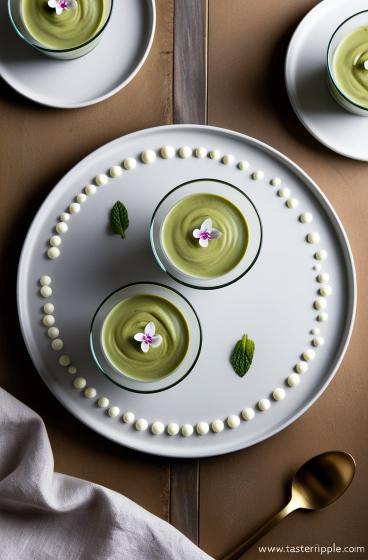There’s something hypnotic about layers — especially when they tell a story. In Matcha Tiramisu in Glass Cups, each layer whispers calm, balance, and intention — a modern twist on an Italian classic told through Japanese minimalism. But beyond its creamy clouds and green tea allure, what truly transforms this dessert is how it’s plated. Served in glass cups, it becomes a visual meditation — soft layers framed like brushstrokes, each element chosen with quiet precision.
Plating, after all, is storytelling without words. And when you combine the earthy depth of matcha with the elegance of glassware, you’re not just serving dessert — you’re curating an experience. Let’s explore the art of presenting Matcha Tiramisu so it feels as luxurious to the eyes as it does to the palate.
The Art of Plating Matcha Tiramisu in Glass Cups
Matcha tiramisu, with its velvety mascarpone and whisper of bitterness, already balances taste beautifully — but visual harmony completes the masterpiece. In glassware, every layer is visible: the green matcha dust, the pale cream, the sponge-soaked base. That transparency demands precision and purpose.
When styling this dessert, lean on five plating principles: balance, contrast, negative space, texture, and height.
Balance begins with symmetry of layers. Each tier should feel measured, deliberate. Unevenness breaks the serenity. The trick? Use a piping bag or spoon with a steady hand to create seamless separations.
Contrast plays softly here — light cream against deep jade matcha, smooth mousse beside airy sponge. Glass cups naturally highlight this interplay, turning every spoonful into a study in yin and yang.
Negative space matters even in transparent plating. Don’t overfill — leave breathing room at the top. That empty rim acts like a frame, emphasizing what’s within.
Then comes texture — the matte powder of matcha against glossy cream creates visual intrigue. Add dimension with a crumble, a garnish, or a crisp biscuit tucked just so.
Lastly, height. Layering itself builds gentle verticality, but you can enhance it by playing with glass shapes — tall tumblers evoke elegance, wide ramekins feel intimate. Choose what tells your story.
In plated desserts like this, presentation transforms perception. What could be a casual no-bake sweet becomes a centerpiece — a minimalist sculpture of flavor and form.
Plating Techniques & Decoration Ideas
Let’s dive into the styling process — not just assembling, but designing your Matcha Tiramisu.
Step-by-Step Plating Technique
- Select Your Vessel
Glass is non-negotiable — it’s the star. Choose vessels that suit the occasion:- Tall glass cups for dramatic layering.
- Short tumblers for a cozy, bistro feel.
- Stemmed dessert glasses for fine-dining finesse.
- Create Clean Layers
Begin with a sponge or ladyfinger base soaked in matcha syrup. Spoon in mascarpone cream. Smooth edges with a spatula or the back of a spoon. Repeat with precision — this dessert thrives on order. - Dust with Purpose
Use a fine mesh sieve to rain matcha powder evenly across the top. Avoid clumps. Think snowfall, not storm. - Garnish Thoughtfully
This is where artistry blossoms. Add one or two accents only — perhaps a white chocolate curl, a tiny edible flower, or a golden spoon leaning elegantly inside the glass. Simplicity signals refinement. - Frame the Scene
Present the cups on a rustic wooden tray, a ceramic slate, or minimalist marble slab. Surround with subtle textures — a linen napkin, bamboo whisk, or tiny bowl of loose matcha for context.
Visual & Sensory Touches
Use color as mood language. The muted green of matcha conveys serenity — pair it with neutrals (cream, beige, ivory) rather than bright hues.
Think about shapes: circular cups mirror the calm curves of Japanese pottery, while square ramekins suggest modernity.
Play with textures: a smooth cup surface next to a rough ceramic saucer creates tactile contrast.
Styling Variations
- Minimalist Fine-Dining
One tall glass, layers razor-clean. A single edible flower — perhaps a micro-orchid — rests on the top. Serve on a black slate with a brushed gold spoon. Quiet, confident, poetic. - Rustic Homestyle
Wide glass jars on a wooden board. Dust matcha generously and top with crumbled shortbread or pistachios. Add a curl of cream and scatter a few crumbs for warmth and charm. - Playful Festive
Use short round glasses. Pipe cream in swirls and dust with matcha in a heart or star stencil. Garnish with tiny mochi balls or white chocolate pearls — whimsical yet elegant. - Zen Garden Aesthetic
Layer thinly in a shallow glass bowl. On top, sift matcha in raked-line patterns using a stencil or chopstick. Add a single mint leaf to echo the garden theme. - Modern Artistic
Serve deconstructed: one layer of soaked sponge, one quenelle of cream beside, a brushstroke of matcha syrup across a rectangular glass plate. A nod to avant-garde plating.
Every variation tells a slightly different story — from contemplative tea ceremony to playful afternoon indulgence.
Light Recipe Overview
To plate beautifully, you must understand your medium. Here’s a simplified version of the Matcha Tiramisu recipe — just enough context for inspired styling:
- Base: Ladyfingers or sponge cake
- Syrup: Matcha whisked with hot water and sugar
- Cream Layer: Mascarpone, sugar, egg yolks (or whipped cream for no-egg version)
- Finish: Matcha dusting
Assembly: Soak the base lightly in matcha syrup. Layer with cream. Repeat once or twice. Chill 4–6 hours for structure.
Because the flavor leans earthy, creamy, and mildly bitter, match it visually with natural tones and delicate details. Avoid bold reds or overly sweet décor; they’ll jar against the matcha’s calm spirit. Instead, emphasize purity and restraint — think soft whites, pale golds, and green accents.
Expert Tips & Common Mistakes
Even the most elegant dessert can falter under poor styling. Here’s how professionals keep their plating sharp and serene.
Expert Tips
- Light matters. Photograph or serve under soft, diffused light. Natural daylight from the side enhances glass reflections and the luminous green of matcha.
- Keep tools clean. Smudges on glass ruin the illusion. Wipe edges after each layer.
- Precision dusting. Use a small fine sieve and hold high to achieve a soft, even coat.
- Contrast in garnish. Add one light accent — white chocolate shard, edible flower, or mint sprig — to break the green monotony.
- Temperature awareness. Serve slightly chilled; condensation fog can obscure your careful layers.
Common Mistakes
- Overfilling cups. Leave headspace for visual relief — too full looks heavy.
- Messy layers. Uneven cream or crumbs on glass distract the eye.
- Excessive garnish. Two is company; three’s a crowd. Over-decorating breaks the zen mood.
- Harsh lighting. Direct top-down light can cast glare on glass — soften it with curtains or diffusers.
- Ignoring background. Glass plating relies on context — your tray, napkin, or surface should complement, not compete.
Remember: discipline equals elegance. Every gesture should feel intentional, not accidental.
When to Serve & Impress
Matcha Tiramisu in Glass Cups is a dessert for quiet celebrations and refined company. Its minimalist presentation and gentle color palette make it perfect for afternoon tea, dinner parties, or romantic evenings.
For holiday gatherings, serve on a large tray with uniform cups — their symmetry adds a festive rhythm.
For date nights, lean into intimacy — two glasses side by side, soft lighting, a shared spoon.
For modern dinner parties, try trio plating — three mini glasses per guest, each styled differently (classic, rustic, deconstructed).
Your plating style sets the mood. A minimalist setup soothes; a playful one charms. Every choice — from vessel to garnish — communicates emotion.
Conclusion
In the world of culinary styling, plating isn’t decoration — it’s translation. It takes the language of flavor and renders it visible. With Matcha Tiramisu in Glass Cups, you’re not just layering cream and sponge — you’re layering calm, craft, and culture.
So next time you prepare this serene green dessert, treat it like art. Choose your glass like a frame, your dusting like brushwork, your garnish like punctuation.
✨ Save this plating guide, try these plating techniques at home, and tag your creations — show the world how your dessert tells its story. Because in the end, food isn’t just to be eaten — it’s to be admired, too.


